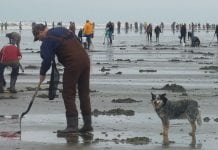Submitted by Washington State Department of Agriculture
As summer gets into full swing and people spend more time outside, state and federal officials and local beekeepers hope the public will keep their eyes open and report any sightings of Asian giant hornet.
“When it comes to preventing and stopping a new invasive species, we all have a role to play and this is a great example,” said Justin Bush, executive coordinator of the Washington Invasive Species Council. “The first detection of Asian giant hornet in the entire United States was made by an aware member of the public. Every other detection since has been made by everyday citizens. Being aware of new plants and animals or changes in your community and then letting the experts know if something seems like a problem can save thousands, if not millions of dollars, in damages.”
This bee-killer already has been spotted in two different cities in Washington this year even though Asian giant hornets aren’t expected out in larger numbers until July or August. That’s when worker hornets become active and the queens stop leaving the nests.
The hornets tend to be most active in the summer and fall when workers search for food away from their nests. Officials ask the public to report sightings as quickly as possible and give details of what they saw and where. Photographs are strongly encouraged if they can be taken safely. If the hornet is dead, please save it for testing. Reports may be made using the Washington Department of Agriculture’s (WSDA) Hornet Watch Report Form, the WA Invasives reporting app or on the Washington Invasive Species Council’s Web site.
For those who wish to trap hornets on their own land and report results to the agency, WSDA created citizen scientist trapping information. No commercial traps are available for Asian giant hornets. While anyone can get involved with trapping, residents of Clallam, Island, Jefferson, San Juan, Skagit, and Whatcom Counties especially are encouraged to participate.
“The public has, and continues to, play a critical role in the response to Asian giant hornet,” said Sven Spichiger, managing entomologist for the WSDA. “We can only put up so many traps, but if people are on the lookout for them, it greatly increases our odds of finding and eradicating them.”
When Asian giant hornet reports are confirmed by WSDA additional traps likely will be placed in the area to help determine the exact location of an Asian giant hornet nest. WSDA will eradicate nests when they are found.
“We are closely monitoring the situation and providing technical and financial support to WSDA as they work to find and eradicate this pest,” said Tim St. Germain, State Plant Health director with U.S. Department of Agriculture’s Animal and Plant Health Inspection Service (APHIS). “These finds indicate that there’s a population of Asian giant hornets in northwest Washington, but APHIS does not consider the population to be established. APHIS considers a pest to be established in an area when there is evidence of a reproducing population over multiple years.”
For more information, visit the WSDA Web page dedicated to Asian giant hornet, as well as the Washington Invasive Species Council’s Web site where resources, Webinars and fact sheets on all types of invasive species are available. Join a network of citizen scientists trapping Asian giant hornet by visiting the WSDA trapping Web page.













































